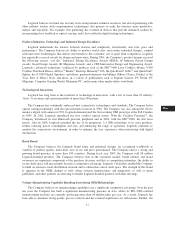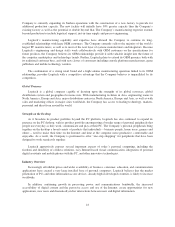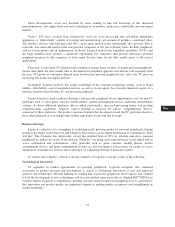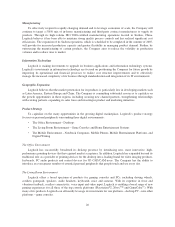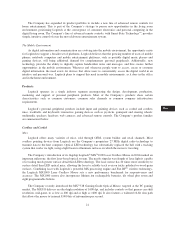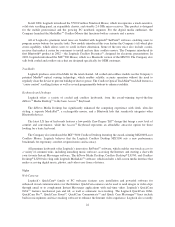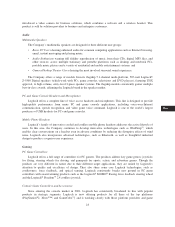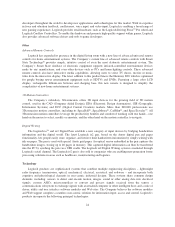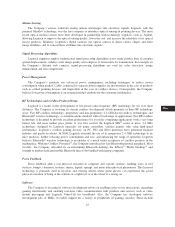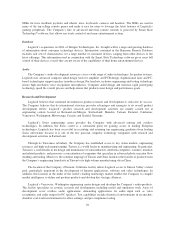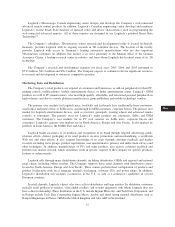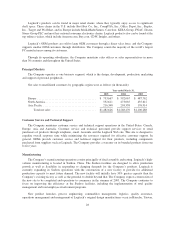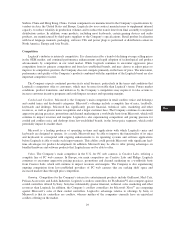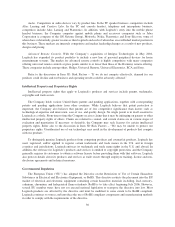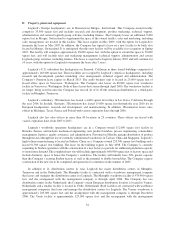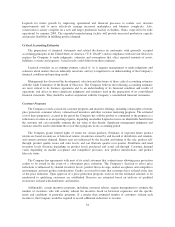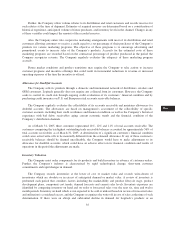Logitech 2005 Annual Report Download - page 63
Download and view the complete annual report
Please find page 63 of the 2005 Logitech annual report below. You can navigate through the pages in the report by either clicking on the pages listed below, or by using the keyword search tool below to find specific information within the annual report.
Motion Sensing
The Company’s sensors transform analog motion and images into electronic signals. Logitech, with the
patented Marble®technology, was the first company to introduce optical sensing in pointing devices. The most
recent optical motion sensors have been developed in partnership with technology suppliers, such as Agilent,
allowing Logitech to improve the optical sensing quality, lower the cost, and increase the reliability of its optical
mouse products. Similarly, Logitech’s digital cameras use optical sensors to detect colors, shapes and other
image attributes, and to convert these attributes into electronic signals.
Signal Processing Algorithms
Logitech engineers employ sophisticated signal processing algorithms across many product lines to compute
spatial displacements, enhance color image quality and compress or format data for transmission. For example, in
the Company’s Internet web cameras, signal-processing algorithms are used for color extraction, image
enhancement and data compression.
Power Management
The Company’s products use advanced power management, including techniques to reduce power
consumption when needed. Cables connected to separate power supplies are inconvenient in the case of products
such as corded pointing devices, and impossible in the case of cordless devices. Consequently, the Company
believes low power consumption is an essential product attribute for the consumer marketplace.
RF Technologies and Cordless Product Design
Logitech is a leader in the development of low-power radio frequency (RF) technology for use over short
distances. The Company is focusing its current cordless development efforts primarily in three RF technology
areas: Fast RF cordless technology, proprietary and non-proprietary 2.4 GHz-based cordless technologies and
Bluetooth®wireless technology, a communications standard with a broad range of applications. Fast RF cordless
technology is designed to provide excellent performance for everyday computing applications with a very long
battery life and mass market price points; it was first used in the Logitech MX™series of mice. 2.4 GHz
technology, designed by Logitech especially for game controllers, satisfies gamers who value high-speed
performance. Logitech’s cordless gaming devices, on PC, PS2 and Xbox platforms have generated frequent
industry and media accolades. In 2004, Logitech extended the use of its proprietary 2.4 GHz technology to its
mice products, further reducing power consumption and size, and enhancing the range of operation. Logitech
believes Bluetooth®wireless technology is an enabler of a much wider acceptance of cordless products in the
marketplace. With the Cordless Presenter™, the Company introduced its first Bluetooth personal peripheral. Most
recently, the Company refreshed its award-winning Bluetooth desktop, the diNovo™Media Desktop™and
brought to market dedicated mobile Bluetooth mice to be bundled with laptop computers.
Force Feedback
Force feedback adds a real physical sensation to computer and console systems, enabling users to feel
surfaces, bumps, vibrations, textures, inertia, liquids, springs, and many other physical phenomena. This licensed
technology is primarily used in joysticks and steering wheels where game players can experience the actual
physical sensation of being at the controls of a fighter jet or at the wheel of a racing car.
Software
The Company is focusing its software development efforts on enabling easier-to-use interactions, expanding
gaming functionality and enabling real-time video communication with products and services such as video
instant messaging and Logitech VideoCall for broadband. Also, the Company has developed software
development kits, or SDKs, to enable support for a variety of peripherals on gaming consoles. These include
25
CG
20-F
LISA




